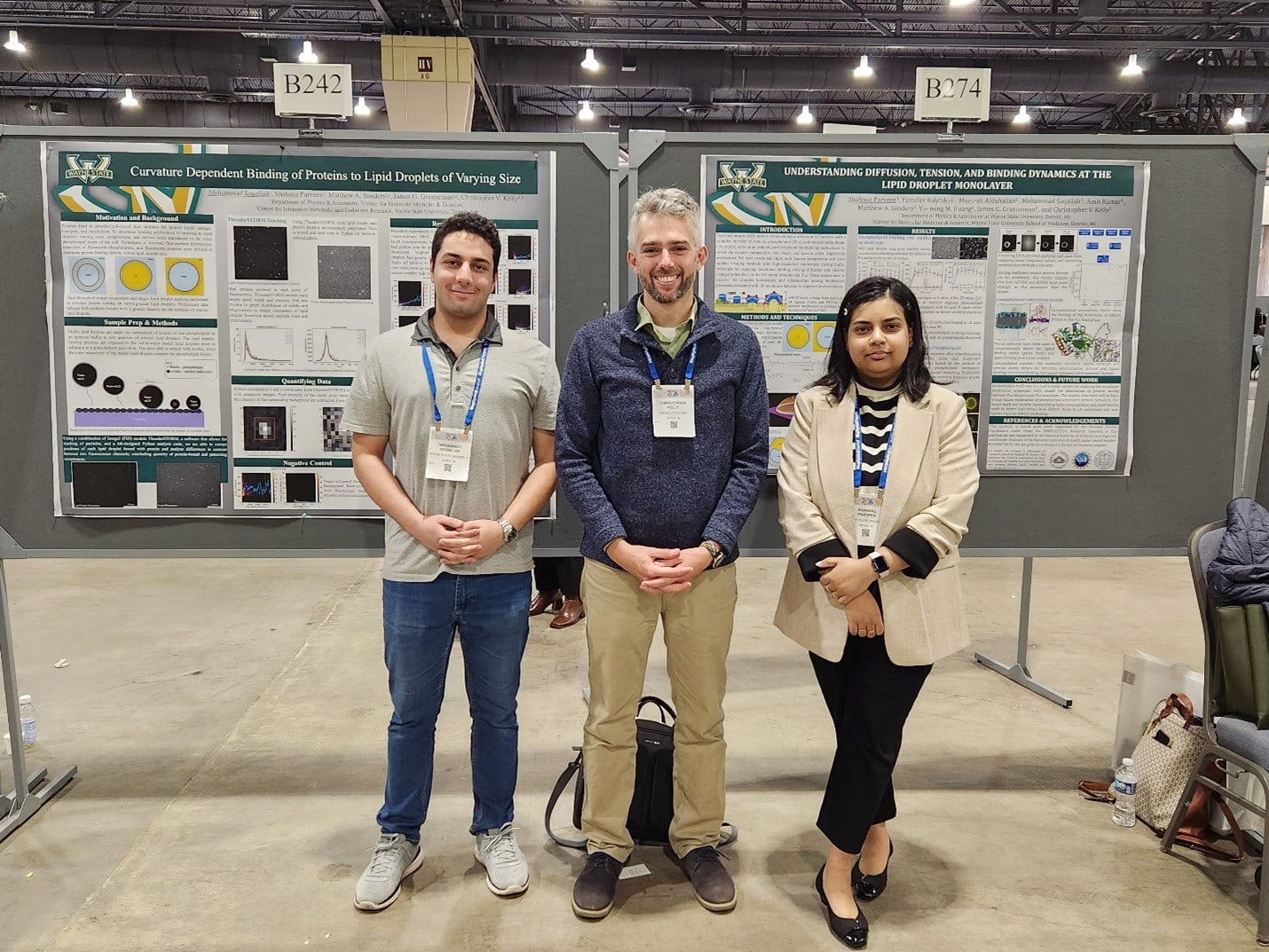Barber Integrative Metabolic Research Program: The gateway to resolving diabetes and cancer
In a groundbreaking collaboration, Wayne State University Physics Professors Christopher Kelly and Mindy Huang, along with a select team of researchers, have recently been honored with a Barber Award for their efforts to understand the fundamental biophysics and therapeutic potential of the protein ABHD5, which plays a critical role in regulating lipid metabolism.
"This protein is key for regulating fat storage and mobilization, which we think can be harnessed to treat obesity, diabetes, fatty liver disease, and cancers," explains Professor Kelly. The collaborative efforts extend beyond the confines of the physics department, encompassing partnerships with faculty members from the School of Medicine and Henry Ford Health, culminating in the establishment of the Barber Integrative Metabolic Research Program.

As a part of a team collaboration, Professor Kelly uses fluorescent microscopy to observe concentrations, diffusion, and clustering of ABHD5 and its binding partners, while Professor Mindy Huang develops computational models to understand the atomistic details of ABHD5’s function. Professor Kelly elucidates, "We physicists can measure nanoscopic shape changes and molecular functions, whereas the biological collaborators examine how living organisms respond to treatment."
This interdisciplinary synergy between physics, computational biology, and experimental biology facilitates a comprehensive understanding of molecular mechanisms dictating lipid metabolism, with each discipline offering unique insights into the intricate interplay of biological systems. As explained by Professor Kelly, "An exciting part of interdisciplinary research is finding the language and terminology to communicate clearly.
Physicists try to find the key to complex systems while using the physical principles that govern them, often informing important biological treatments. By working together, we can see a richer and more accurate picture of these enormously complex systems."
The gift that keeps on giving
Richard Barber’s million-dollar donation, without which the research program would not have been possible, has been of vital importance. In Professor Kelly’s words, "Richard Barber’s generous contribution allowed us to expand our collaborations, form an enthusiastic research group, and pursue greater funding opportunities." Moreover, Wayne State’s Division of Research amplified Mr. Barber’s donation in establishing a robust research infrastructure within the Integrative Biosciences Center (IBio) building.
This transformative support not only accelerates our understanding of basic science and the development of important therapies but also nurtures a cadre of aspiring researchers, including Wayne State students, who engage in research activities under the mentorship of seasoned faculty members.
Emphasizing the profound impact of the Barber Award on student involvement, Professor Kelly underscores the pivotal role of undergraduate researchers in driving scientific innovation. "Having students engaged at all levels is critical to Wayne State's mission and the progression of the research," he asserts. Indeed, the Barber Award enables students to focus on their research in education with hands-on training and provides invaluable opportunities for students like Mohammad Saqallah and Ryadh Alhussein to perform experiments, computationally analyze data, and contribute meaningfully to cutting-edge research. They have designed an experiment to test the effects of membrane shape on ABHD5 with model membranes and fluorescence microscopy.
Reimaging the future
Looking ahead, the faculty members of the Barber Integrative Metabolic Research Program envision a future brimming with personalized molecular therapies, informed by a deep understanding of ABHD5's biological significance. "This project is revealing basic science understandings and working towards personalized molecular therapies", states Professor Kelly. He then explains, "ABHD5 is a receptor of a cell’s natural metabolic state and has proven receptive to small-molecular medicines. Candidate therapeutics can push ABHD5 to turn on enzymes that burn fat or kill cancers.
The first tests are head and neck cancer with a topical application. Future studies will include clinical trials of the therapeutics administered as a pill or injection." To realize this ambitious vision, continued support from philanthropic individuals and organizations is indispensable, enabling the research team to transcend disciplinary boundaries and pioneer novel therapeutic interventions. "With additional funding, we are excited to push it into more diverse treatments with their own scientific and technical challenges" asserts Professor Kelly. "To maximize our impact, we must expand our collaborations to work with chemists, radiologists, and computer scientists while expanding our community outreach and educational efforts."
As the Wayne State community mourns the recent passing of Richard Barber, Professor Kelly pays tribute to his enduring legacy. "Mr. Barber was a long-time, generous supporter of research and education," reflects Professor Kelly. Mr. Barber's donations and guidance were fundamental to the Richard Barber Interdisciplinary Research Program, which supported hundreds of cross-disciplinary collaborations spanning WSU's schools and colleges from 2011 to 2023.
He was insistent that WSU faculty members reach beyond their academic silos through collaboration and the incorporation of undergraduate researchers. His generosity has provided over 180 undergraduate students with incomparable hands-on education and training by providing them with full-time paid research positions during the summers. Although Mr. Barber passed away suddenly in December 2023, the collaborations he initiated and the students he educated will honor his legacy for many years to come.